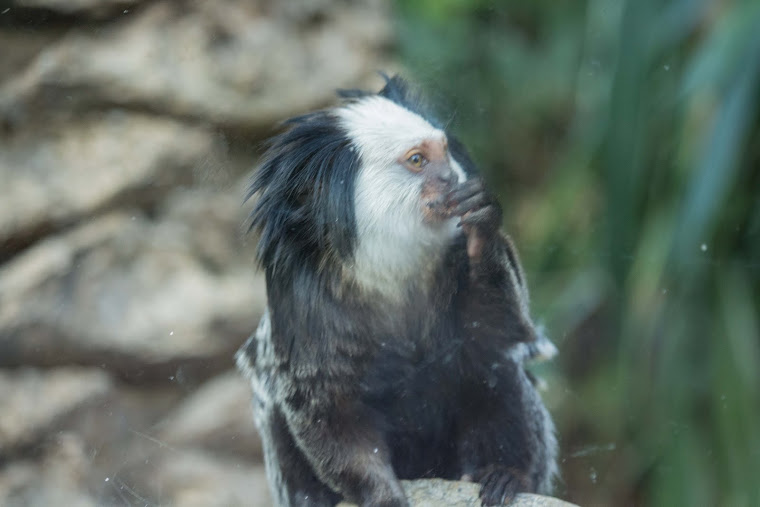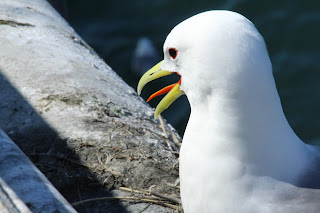 |
| Picture of the Statendam leaving Seattle (courtesy of my friend Dave who lives there) . If you look closely you can see me mooning Seattle. |
Alaska I can find all by myself on a map. What I never realized is just how friggin' far north Alaska really is and what that means in May. It means 4 hours of darkness. I need more sleep than that. I became an expert in arranging extra pillows on the cabin window curtains to block out stray sunbeams. With such long days its tempting to try to stay active the entire time. Good luck with that. 60 is not the new 20.
Alaska in May is teeming with all kinds of creatures. Before I left, I bought a new camera (digital SLR). I had a terrific time trying to translate what is says in the 400 page manual into something worth looking at. Note - all of the pictures here can be expanded by clicking on them.
This is a Kittiwake
The name is derived from its call, a shrill 'kittee-wa-aaake, kitte-wa-aaake'. They are manufactured in two versions. A red legged model and a black legged model.
 |
| red legged version after walking through new, hot asphalt |
Their tongue is as shrill a color as their cry.
Even though the Kittiwakes are abundant
the real star of the Alaskan bird world are these guys:
This is, of course, a "dumpster chicken". No kidding. That's what the natives call them.
The above pictures look all nice and wilderness-like, but in truth, you can find eagles just about anywhere (especially if it looks like there might be a free meal involved).
 |
| (rescue eagle in a shelter, sadly blind in left eye) |
Eagles rule the air, whales rule the waters.
This is a humpback and it's true - their breath smells awful. Disgusting. Wretched. Gack! There were lots of them around trying to exhale on us. I think its a game the whales play. They try to see if they can get a human to yark over the side of the boat. Supposedly, if the light is just right, you can get a feel for what they're eating by the color of the blow. According to our photo guide - pink snot indicates krill feeding. Most had just returned from vacationing in Mexico. While they don't eat Mexican food while they're down in Mexico, they obviously eat something. Their size is impressive. This one dove under the boat.
Humpbacks are by no means the largest of the whales, but even so - damn. It has been estimated that the longissimus dorsi muscle of the humpback (the tail flappie uppie muscle) weighs around 10,000 pounds. You'd need a barbecue the size of a blast furnace to cook it. Surprisingly, the whale tail itself:
 |
| (it was so close to the photography boat that I got excited and zoomed in too close) |
The humpback population in Alaska is estimated to be around 24,000. They seem to be increasing at the rate of 9% per year since 1984. Not bad for such a magnificent creature.
They don't inhabit the water alone. There are lots of these buggers around:
 |
| Note the external ear - this is a sea lion (Steller sea lion to be exact) |
If you're a subsistence living Alaskan - the meat tastes terrific. If you have access to a big Mac, you wouldn't touch seal meat.
In Victoria harbor (yes, I know, that's Canada) I saw this kid "fishing" without a hook.
He was being eyed by a harbor seal. The seal is underwater in these photos
It works.
 |
The northern fur seals are cool to see, but regulations (they are covered by the North Pacific Fur Seal Convention of 1911) won't let you get very close.
Another water mammal that is difficult to photograph is the sea otter.
Yes, they're cute. But don't get too close - the rat bastards bite. The ones we have at the zoo also stink something awful. Ottors are part of the weasel family. If you think your pet ferret smells - get near an otter. The stench will make you gag when you walk into the enclosure. Back in the day, the Russians managed to hunt the sea otters damn near to extinction. From 300,000 individuals down to just 1,000. Today the population is stable at around 100,000. Although I didn't see it, according to a fisherman I talked to, it is common to come across "rafts" of otters numbering in the 1,000's. Apparently they they all link arms and snooze.
On land, this guy rules:
In 1815 the "Grizzly" bear was considered a distinct species of bear. Modern genetic DNA testing has revealed that it isn't. It's just a big, stupid, brown bear. What gets confusing is that there are brown colored "black" bears. They're real easy to tell apart in the field. If it runs away from you - it was a black bear. If it runs towards you - it's a brown bear. Congratulations - you've just been invited as "guest of honor" to a real Alaskan native dinner (you).
Muskox are being reintroduced into Alaska.
Weird creature, not really an ox at all. Tough as hell though.
 |
| Youngster. His mom probably thinks he's cute. |
 |
| close up of his back leg |
A pair of knitted gloves goes for $275.
At a raptor rescue center in Sitka I saw this snowy owl:
 |
| feather foot warmers |
 |
| Duuuuh, which way did he go? Which way did he go? |
I'll end with a bird I've always wanted to see. The Puffin.
Elusive little bastards. During breeding season that big honker of a beak assumes the vivid colors you see above.




























